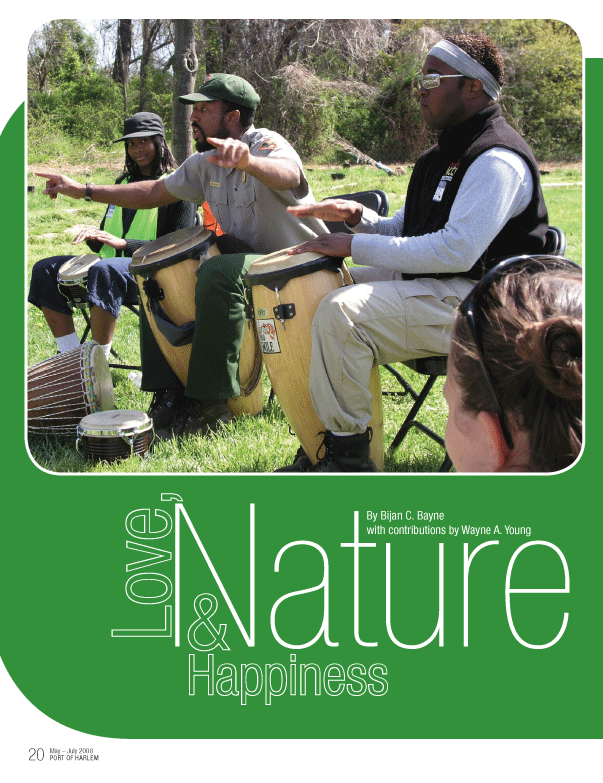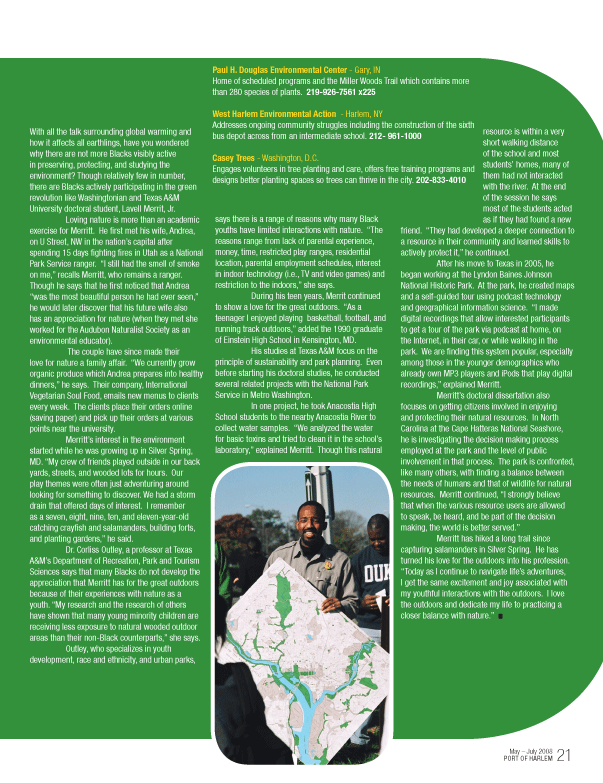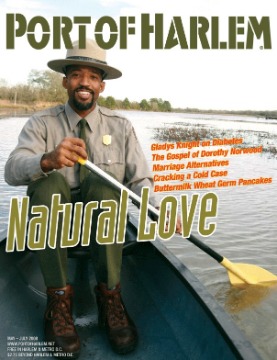Natural Love
MAY - JUL 2008
Volume 14 Number 2
On The Dock
COVER STORY
COVER CREDITS Native Washingtonian, National Park Service Ranger, and Texas A&M University Recreation, Park and Tourism
Sciences doctoral student Lavell Merritt, Jr. canoeing on Woodlake at the rear of his Texas home.
Photo by Jerren
Willis.
20 Love, Nature and Happiness
Loving nature is more than an academic exercise for Lavell Merritt, Jr., a Texas A&M University Recreation, Park and Tourism Sciences doctoral student. He first met his wife, Andrea, on U Street, NW in the nation’s capital after spending 15 days fighting fires in Utah as a National Park Service ranger. The native Washingtonian would later discover that his future wife also has an appreciation for nature (when they met she worked for the Audubon Naturalist Society as an environmental educator). Today, he has turned his love for the outdoors into his profession.
FOCUS Black and Green
22 Planetwalker
23 Back Home
FEATURE
24 Ten Tips for Improving Your Photography
DEPARTMENTS
2 LETTERS TO THE EDITOR
THE PUBLISHER’S POINT
4 Intimacy with Nature
THE OTHER SIDE
5 The Power of Prayer
PRAISING THE PAST
6 A Cold Case Without a Trace
IN FASHION
7 Femi Samuel
MONEY
8 Marriage Alternatives
OUR SPACE
10 National Architects Organization Elects First Black President
TRAVEL STORY
12 The Mere Line
HEALTH
14 Gladys Knight on Diabetes
16 Do You Know Your Pharmacist?
RECIPE
25 Buttermilk Wheat Germ Pancakes with Yogurt and Blueberry Sauce
BOOK REVIEW
26 On the Road to Freedom:
A Guided Tour of the Civil Rights Trail
COMING UP
27 Hampton University Ministers' Conference, Artscape, An Evening with Charlie Cobb and more
ENTERTAINMENT
28 The Gospel of Dorothy Norwood
;
;
;
With all the talk surrounding global warming and how it affects all earthlings, have you wondered why there are not more Blacks visibly active in preserving, protecting, and studying the environment? Though relatively few in number, there are Blacks actively participating in the green revolution like Washingtonian and Texas A&M University doctoral student, Lavell Merrit, Jr.
Loving nature is more than an academic exercise for Merritt. He first met his wife, Andrea, on U Street, NW in the nation’s capital after spending 15 days fighting fires in Utah as a National Park Service ranger. “I still had the smell of smoke on me,” recalls Merritt, who remains a ranger. Though he says that he first noticed that Andrea “was the most beautiful person he had ever seen,” he would later discover that his future wife also has an appreciation for nature (when they met she worked for the Audubon Naturalist Society as an environmental educator).
The couple have since made their love for nature a family affair. “We currently grow organic produce which Andrea prepares into healthy dinners,” he says. Their company, International Vegetarian Soul Food, emails new menus to clients every week. The clients place their orders online (saving paper) and pick up their orders at various points near the university.
Merritt’s interest in the environment started while he was growing up in Silver Spring, MD. “My crew of friends played outside in our back yards, streets, and wooded lots for hours. Our play themes were often just adventuring around looking for something to discover. We had a storm drain that offered days of interest. I remember as a seven, eight, nine, ten, and eleven-year-old catching crayfish and salamanders, building forts, and planting gardens," he said.
Dr. Corliss Outley, a professor at Texas A&M’s Department of Recreation, Park and Tourism Sciences says that many Blacks do not develop the appreciation that Merritt has for the great outdoors because of their experiences with nature as a youth. “My research and the research of others have shown that many young minority children are receiving less exposure to natural wooded outdoor areas than their non-Black counterparts,” she says.
Outley, who specializes in youth development, race and ethnicity, and urban parks, says there is a range of reasons why many Black youths have limited interactions with nature. “The reasons range from lack of parental experience, money, time, restricted play ranges, residential location, parental employment schedules, interest in indoor technology (i.e., TV and video games) and restriction to the indoors,” she says.
During his teen years, Merrit continued to show a love for the great outdoors. "As a teenager I enjoyed playing basketball, football, and running track outdoors,” added the 1990 graduate of Einstein High School in Kensington, MD.
His studies at Texas A&M focus on the principle of sustainability and park planning. Even before starting his doctoral studies, he conducted several related projects with the National Park Service in Metro Washington.
In one project, he took Anacostia High School students to the nearby Anacostia River to collect water samples. “We analyzed the water for basic toxins and tried to clean it in the school’s laboratory,” explained Merritt. Though this natural resource is within a very short walking distance of the school and most students’ homes, many of them had not interacted with the river. At the end of the session he says most of the students acted as if they had found a new friend. “They had developed a deeper connection to a resource in their community and learned skills to actively protect it,” he continued.
After his move to Texas in 2005, he began working at the Lyndon Baines Johnson National Historic Park. At the park, he created maps and a self-guided tour using podcast technology and geographical information science. “I made digital recordings that allow interested participants to get a tour of the park via podcast at home, on the Internet, in their car, or while walking in the park. We are finding this system popular, especially among those in the younger demographics who already own MP3 players and iPods that play digital recordings,” explained Merritt.
Merritt’s doctoral dissertation also focuses on getting citizens involved in enjoying and protecting their natural resources. In North Carolina at the Cape Hatteras National Seashore, he is investigating the decision making process employed at the park and the level of public involvement in that process. The park is confronted, like many others, with finding a balance between the needs of humans and that of wildlife for natural resources. Merritt continued, “I strongly believe that when the various resource users are allowed to speak, be heard, and be part of the decision making, the world is better served.”
Merritt has hiked a long trail since capturing salamanders in Silver Spring. He has turned his love for the outdoors into his profession. "Today as I continue to navigate life's adventures, I get the same excitement and joy associated with my youthful interactions with the outdoors. I love the outdoors and dedicate my life to practicing a closer balance with nature.”
Paul H. Douglas Environmental Center - Gary, IN
Home of scheduled programs and the Miller Woods Trail which contains more than 280 species of plants. 219-926-7561 x225
West Harlem Environmental Action - Harlem, NY
Addresses ongoing community struggles including the construction of the sixth bus depot across from an intermediate school. 212-961-1000
Casey Trees - Washington, D.C.
Engages volunteers in tree planting and care, offers free training programs and designs better planting spaces so trees can thrive in the city. 202-833-4010









